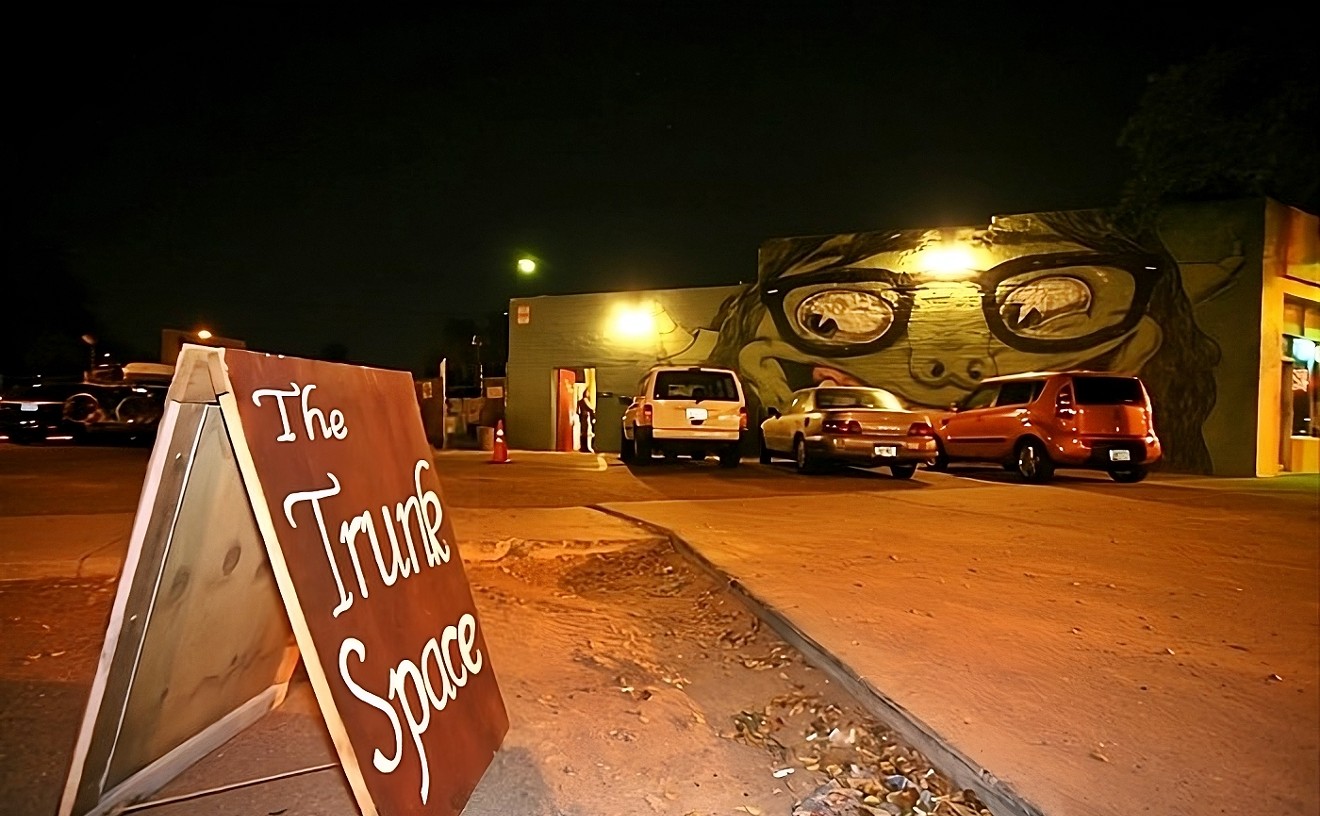Michael Dixon's no different, except his situation may be more challenging. The artist's mother is white and his father is black. Dixon explores his ongoing wrestle with identity in "Sambo Scratches His Navel and Watches His Crazy Sister" at West Valley Art Museum.
The exhibition features paintings of a nude woman, covered in black paint from head to toe. Red and white circles cover her eyes and mouth to mimic blackface makeup. The figure is actually Dixon's collaborator, Onye Ozuzu, whose dance/art performance Minstrel Mask inspired the work in this exhibition.
Minstrel Mask is Ozuzu's ongoing dance piece, inspired by the religious mythology of the African deity Ellegua (associated with "opening the ways" or crossroads) and the American icon Sambo (among other meanings, "sambo" is a pejorative term for a person of mixed descent).
Ozuzu is an associate professor at University of Colorado at Boulder in the Department of Theater and Dance. She, like Dixon, is of mixed-culture background. Her father is from Kenya and her mother is a Caucasian American. While working on his master's degree in Boulder, Dixon saw Minstrel Mask and felt a kinship with Ozuzu. As he writes in his artist statement, "It seemed as though she was trying to break free from the exterior identity that held her trapped beneath its blackness. Onye was trying to reclaim herself."
Dixon and Ozuzu began a two-year dialogue and collaboration. The result is this show, a series of paintings by Dixon that show Ozuzu applying the dramatic makeup and dancing. At the show's première at The Dairy Center in Boulder, Ozuzu performed her dance in full makeup among Dixon's paintings. She's now pregnant, so she won't be coming to WVAM to perform.
Though it would have been an incredible experience to see Ozuzu dance, the imagery in this show is strong enough to stand on its own. What's most impressive is the range of character Dixon captures in his paintings of Ozuzu. In You Don't Know About Me . . . The New Face of America, her face is only partially painted and she looks straight on with a sad, vulnerable expression. In I Hopes I Shall Hab De Honor Ob Displeasing You All, her mouth belches an ornery, rebellious tongue. And in Ellegua vs. Sambo, her hands extend like weapons and her face snarls; she looks ferocious, frightening and ready to attack. Finally, in Bring Back Those Old Faces in Black, Features We All Love So . . ., she assumes a goofy expression with dopey eyes and a big grin.
Racial identity is no new topic for Dixon. He never met his father and was raised by the white side of his family. His mother and grandmother were his parental figures, but not every family member was so accepting. His Mississippi-born maternal grandfather referred to him as "that little pickaninny." He grew up in a diverse neighborhood in San Diego but moved to a predominantly white neighborhood while in high school. It was during this time that Dixon experienced overt racism from his peers.
In his work, Dixon often grapples with his mixed-race descent. A previous series of paintings, titled Chameleon I, II, II . . ., shows self-portraits of Dixon shaving off his Afro (you may have caught one of the paintings at Shemer Art Center in May 2008). "Sambo Scratches" certainly has its fair share of autobiography — large-scale paintings of both parents are included — but Dixon allows his viewers to witness a collective identity search by teaming up with Ozuzu.
There are more than 15 portraits of Ozuzu in various stages of paint. Her makeup clearly takes root in blackface, an application first used in minstrel acts popular in the 19th century. The performances depicted African Americans as buffoonish, jolly, and superstitious. Blackface is now seen as offensive, and the imagery is, without a doubt, a hot button.
Through Dixon's paintings, you won't be able to get much sense of Ozuzu's performance. But you'll witness the transformation of her identity. Dixon masterfully chooses different points in the makeup process. Not Too Black depicts a woman's face (one of Ozuzu's assistants) with Ozuzu's bright red palm splayed in front of it. The woman's eyes downcast, her mouth taut, she is concentrating as she lays the paint-filled brush bristles along the back of the hand. I don't know why Dixon chose to show this particular moment, but it brings serenity to the show. Particularly when the images of a fully painted Ozuzu are so energetic and demanding, this quiet moment in preparation is a relief.
His most powerful work is Sailor Ray Rumph Wouldn't Have No Mixed Grandson. The large painting features yet another portrait of Ozuzu. Here, her painted, dancing figure dominates the right side of the canvas. Her arms are raised and her hands dangle behind her head. Her face looks forward and her mouth is curled in a slight frown; her eyes are on the verge of spilling tears. An outline of the United States runs over her body (Florida lands in her armpit) and continues to the left side of the canvas. Dixon includes some loose sketches on this half. The drawings are made with a quick hand and show an older gentleman picking up a young boy. The boy boasts a pretty serious Afro while the old man throws him up in the air — the man has a full head of white, straight Caucasian hair. You can see only the old guy's profile, but with a bouquet of crows' feet and a dimpled cheek, it's obvious he's smiling. He stares up at the child with total adoration and delight.
Knowing that Dixon was judged for his mixed race by his white grandfather makes it all the more devastating. The play between grandpa and grandson yearns for a moment when the boy wasn't black or white, he was just family.










